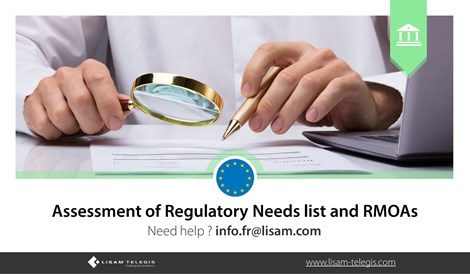Assessment of Regulatory Needs list and RMOAs
Assessment of Regulatory Needs list and RMOAs
mercredi 19 janvier 2022
 Risk Management Options Analysis (RMOA) is a methodology that was first introduced in February 2013. It helps identify the dangers or risks for the health and/or environment posed by hazardous substances and is used to determine the best risk management measures for addressing potential concerns with these substances. Substances can for example be assessed due to their potential endocrine disrupting or persistent, bioaccumulative and toxic properties. This methodology can help prevent the unnecessary substitution of certain substances.
Risk Management Options Analysis (RMOA) is a methodology that was first introduced in February 2013. It helps identify the dangers or risks for the health and/or environment posed by hazardous substances and is used to determine the best risk management measures for addressing potential concerns with these substances. Substances can for example be assessed due to their potential endocrine disrupting or persistent, bioaccumulative and toxic properties. This methodology can help prevent the unnecessary substitution of certain substances. The Member State authorities implemented these RMOAs so that they can manage the risks involved with using these substances, on the basis of the information provided in the registration dossiers of the substances. The Member States will discuss the RMOAs with ECHA and the European Commission before concluding on the regulatory measures that will be adopted. Examples of measures that can be taken are the following: harmonized classification and labelling, Candidate List inclusion, restriction...
In 2019, ECHA started assessing the regulatory needs for groups of chemicals, as part of the Integrated Regulatory Strategy (IRS). The RMOAs are therefore now included in the Assessment of Regulatory Needs list (ARN list), which is a list of substances with their structural similarity groups for which an assessment is either ongoing or has been completed. This list gives the assessing authority, the concern, the status, the suggested follow-up action, and the date of the latest update to the list entry.
ECHA confirmed in December 2021 that around 120 groups have been assessed overall, covering more than 3 000 substances. They started assessing structurally similar substances together to speed up the process to eventually address all registered substances. Structurally similar substances are identified using the substance identity information in registration dossiers and C&L notifications. This means that authorities can treat related substances consistently and can take action for substances of concern as soon as possible.
Assessing substances in groups also helps companies identify substances that will be assessed and potentially regulated based on the chemical structure of a substance, meaning that they can sometimes predict authorities’ decisions. Before this, ECHA focused on substances that presented sufficient hazard information in order to determine whether they required regulatory risk management. Now, if a substance has been identified, all structurally similar substances can go straight to regulatory risk management even if insufficient hazard information is available.
The assessment is done on a group of substances, but the decision to take regulatory action can apply to the group of substances as a whole, or only a subgroup or single substance. This decision is notified through the Registry of Intentions of a substance. This can therefore help companies prepare themselves to replace substances with safer alternatives if needed.
